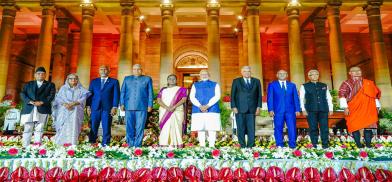The potential of regional social spending in India's soft power projection
Apart from being the largest country in the region in terms of geography and economy, New Delhi’s responsibilities as an important player in South Asia also rest on its efforts to improve the region's social and economic parameters.

Recent elections in South Asian countries revealed some interesting trends in the region’s evolving socio-economic aspirations. In India, the narrow victory of the Bhartiya Janta Party (BJP)-led National Democratic Alliance (NDA), combined with the partial resurgence of the Indian National Congress (INC)-led Indian National Developmental Inclusive Alliance (I.N.D.I.A), hold valuable lessons not only for emerging democracies in South Asia but also for New Delhi's foreign policy strategies in and around its region. With development as a central focus, the mandate indicated that socio-economic priorities continue to dominate the electoral discourse not only in Indian politics but throughout South Asia.
Electoral rhetoric in the leadup to this year's elections in South Asian countries, including Bhutan, Pakistan, and the forthcoming Sri Lankan elections too reflected an overwhelming focus on economic concerns that prioritises the social and economic upliftment of communities that survive on the margins. India, which is comparatively better positioned in terms of its economic stability, has an opportunity to add significant value to the region’s effort in addressing such developmental concerns.
Meeting regional developmental aspirations
If one were to interpret a definitive message from the Indian electorate, it would intrinsically point toward the centrality of people-centric policies along with fulfilment of basic developmental needs. These aspirational needs and wants are not confined to the Indian electorate alone but equally relevant to the entire Indian subcontinent. The South Asian region lags significantly behind other regions on most if not all, social and developmental indicators. Countries in the subcontinent are only second to the Sub-Saharan African countries in terms of numbers and proportion of the world’s extremely poor. Even though governmental policies in each of the region’s countries are welfare-driven and necessitated from its socio-economic needs, the outcomes of these efforts have largely underperformed in terms of their pace in addressing immediate developmental concerns.
India, on the other hand, has seen some success in developing last-mile strategies that have enhanced its socioeconomic trajectory. Not only is the Government of India the largest programme runner of social schemes, but it is also simultaneously developing soft and hard infrastructures that facilitate the delivery of such programs.
Take the Direct Benefit Transfer (DBT) process for example. The DBT was a crucial poll issue due to its popularity among rural voters and has played a key role in India's social security system for the past few decades. Apart from attempts at uplifting the socio-economic statuses, the DBT has also ensured the financial and economic inclusion of the marginalised who have largely remained excluded from India’s growth trajectory. More importantly, in pursuit of enrolling processes such as the DBT into India’s social security framework, a robust institutional and technological mechanism was established to ensure the efficiency and efficacy of various follow-up schemes. From addendum programs encouraging the initiation of bank accounts for DBTs to ensure mobile connectivity for verification of such transfers, the infrastructural development of corresponding sectors has acted as force multipliers in the overall development of the social sector.
Although India still faces challenges in achieving complete operational efficiency and including all potential beneficiaries, the ripple effect of timely delivery and minimal proliferation has led to greater benefits in terms of both financial inclusion and meeting the developmental aspirations of the marginalised.
Re-orienting India's neighbourhood policy
In light of these experiences, New Delhi’s South Asian policy must effectively utilise the immense export potential of including such welfare-oriented processes in its larger neighbourhood policy. Until now, bilateral social assistance between India and South Asian counterparts has largely focused on humanitarian assistance for disaster relief, financial grants, and medical assistance for COVID-19-related matters. A subset of this focus, in recent years, has also emphasised on capacity building and training programs including in the health and education sector. By expanding this assistance ambit to include the export of specific governance systems and knowledge cooperation vis-a-vis welfare schemes, New Delhi would also be laying the path for subsidiary infrastructure development that targets the elevation of socio-economic parameters.
While the expenditure on health, education and social assistance requires stable revenue sources, countries in the region would do well with efficient and effective utilization of their spendings that generate greater returns. Furthermore, the process and knowledge-sharing exercise is a cost-efficient measure that can begin without hefty financial investments. Thus, this form of cooperation, coupled with third-party collaborations, has the potential to significantly enhance soft and hard infrastructure development simultaneously in areas such as digitization, banking services, and other relevant sectors.
Strengthening regional social spending
Assistance in the social sector is, however, also a two-way street. Regular consultation for both knowledge sharing and gaining will elevate the overall economic trajectory of the region, including for India which would benefit immensely from such consultation processes. These collaborations can be strengthened through discussions on overcoming challenges that necessitate unique and people-centric solutions and be mutually beneficial, considering the shared needs and aspirations that the region collectively envisions.
A secondary yet important factor that would greatly enhance India's image in the region would be to be perceived as a genuinely committed partner prioritizing the fulfillment of regional developmental aspirations rather than focusing on quid pro quo gains. The presumption that New Delhi’s South Asian policy is largely security-driven must give way to a perception that regional developmental aspirations can be met majorly through Indian assistance in both soft and hard infrastructure development, especially in the social sector.
Apart from being the largest country in the region in terms of geography and economy, New Delhi’s responsibilities as an important player in South Asia also rest on its efforts to improve the region's social and economic parameters. Strengthening regional social spending schemes and developing subsidiary infrastructure will ultimately project New Delhi as a partner that aims to promote self-sufficiency and sustainable growth among South Asian nations. New Delhi’s neighbourhood policy must consider addressing the potential of assisting South Asian partners in enhancing their social sectors and leveraging the expertise it has developed over the years to enhance its regional and global standing.
(The author is a Research Associate at the Organisation for Research on China and Asia (ORCA), New Delhi. He is the co-editor of a special issue on "India's Soft Push for Power in South Asia: Shaping a Favourable Tomorrow". Views are personal. He can be contacted at ratishmehta23@gmail.com X handle is: @ratish_mehta and Linkedin handle is linkedin.com/in/ratish-mehta-7172271ab)









Post a Comment